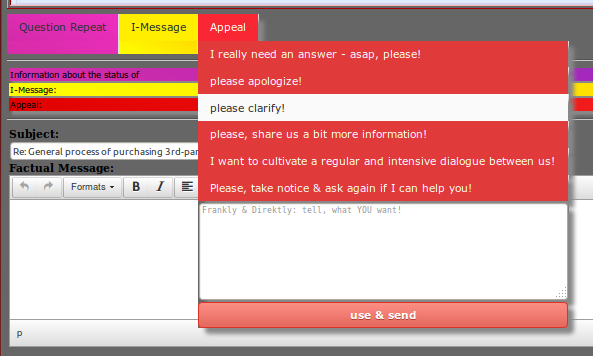One of our USPs: the CFLX
How the CFLX improve the understanding - for man and machine...
CFLX ([Si:flæg's] Clarity Statements) are designed to improve communication in distributed teams by clarifying the implicit parts of messages, thereby reducing misinterpretations. These statements enhance understanding by explicitly addressing the factual, self-revelation, relationship, and appeal aspects of communication.
Detailed Explanation
Problem to Solve
In distributed teams, communication often lacks the non-verbal cues present in face-to-face interactions, leading to misinterpretations and misunderstandings. This problem is exacerbated by the fact that communication contains both explicit (factual) and implicit (relationship, self-revelation, appeal) elements, the latter of which are frequently filtered out in text-based communication.
Communication Theory
Based on theories by Paul Watzlawick and Friedemann Schulz von Thun, every message has a content and a relationship aspect. Schulz von Thun's Four-Sides Model further subdivides messages into factual information, self-revelation, relationship, and appeal aspects. In virtual communication, these implicit parts are often lost, leading to potential misinterpretations.
Designing a Solution
CFLX are integrated into the CYBR-SUITE to enhance communication in remote team project collaboration. This system addresses communication challenges by making implicit parts of messages explicit. Every "factual" message is accompanied by three mandatory CFLX statements: a "Status Statement," an "I-Message," and an "Appeal."
-
The Status Statement clarifies the current situation, whether it's the progress of a task, the state of a sprint goal, or the daily status.
-
The I-Message allows team members to express their personal insights or thoughts about the task or situation.
-
The Appeal specifies what is needed to deliver a solution, solve a problem, or inform others in the team.
These elements ensure that all parts of a message are clear and comprehensible, aiding both human understanding and data-collecting machines in interpreting the intentions behind the communication. Flags for repeating questions or making appeals expand on mouse-over, allowing users to select or modify predefined statements or enter new ones, further refining the clarity and precision of each message.
Application
CFLX are embedded throughout the CYBR-SUITE, assisting in various contexts such as SCRUM item discussions and virtual shop-floor management. By making implicit information explicit, CFLX help team members make better guesses about the intentions behind messages, reducing misunderstandings and improving overall communication efficacy.
Learn More







